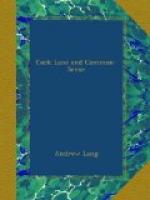To the cases of savage table-turning (p. 49), add Dr. Codrington’s curious examples in The Melanesians, p. 223 (Oxford, Clarendon Press, 1891).
To stories of fire-handling, or of walking-uninjured through fire (p. 49), add examples in The Journal of the Polynesian Society, vol. ii., No. 2, June, 1893, pp. 105-108. See also ’At the Sign of the Ship,’ Longman’s Magazine, August, 1894, and The Quarterly Review, August, 1895, article on ‘The Evil Eye’.
Mr. J. W. Maskelyne, the eminent expert in conjuring, has remarked to the author that the old historical reports of ’physical phenomena,’ such as those which were said to accompany D. D. Home, do not impress him at all. For, as Mr. Maskelyne justly remarks, their antiquity and world-wide diffusion (see essays on ’Comparative Psychical Research,’ and on ‘Savage and Classical Spiritualism’) may be accounted for with ease. Like other myths, equally uniform and widely diffused, they represent the natural play of human fancy. Inanimate objects are stationary, therefore let us say that they move about. Men do not float in the air. Let us say that they do. Then we have the ‘physical phenomena’ of spiritualism. This objection had already occurred to, and been stated by, the author. But the difficulty of accounting for the large body of respectable evidence as to the real occurrence of the alleged phenomena remains. Consequently the author has little doubt that there is a genuine substratum of fact, probably fact of conjuring, and of more or less hallucinatory experience. If so, the great antiquity and uniformity of the tricks, make them proper subjects of anthropological inquiry, like other matters of human tradition. Where conditions of darkness and so on are imposed, he does not think that it is worth while to waste time in examination.
Finally, the author has often been asked: ’But what do you believe yourself?’
He believes that all these matters are legitimate subjects of anthropological inquiry.
London, 27th October, 1895.
INTRODUCTION.
Nature of the subject. Persistent survival of certain Animistic beliefs. Examples of the Lady Onkhari, Lucian, General Campbell. The Anthropological aspect of the study. Difference between this Animistic belief, and other widely diffused ideas and institutions. Scientific admission of certain phenomena, and rejection of others. Connection between the rejected and accepted phenomena. The attitude of Science. Difficulties of investigation illustrated. Dr. Carpenter’s Theory of unconscious Cerebration. Illustration of this Theory. The Failure of the Inquiry by the Dialectical Society. Professor Huxley, Mr. G. H. Lewes. Absurdity and charlatanism of ‘Spiritualism’. Historical aspect of the subject. Universality of Animistic Beliefs, in every stage of culture. Not peculiar to savagery, ignorance, the Dark Ages, or periods of Religious crisis. Nature of the Evidence.




